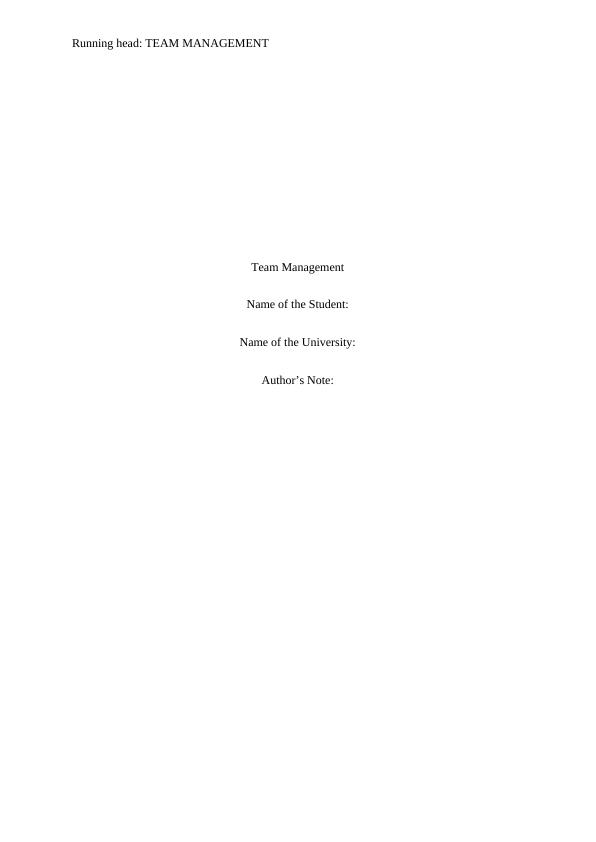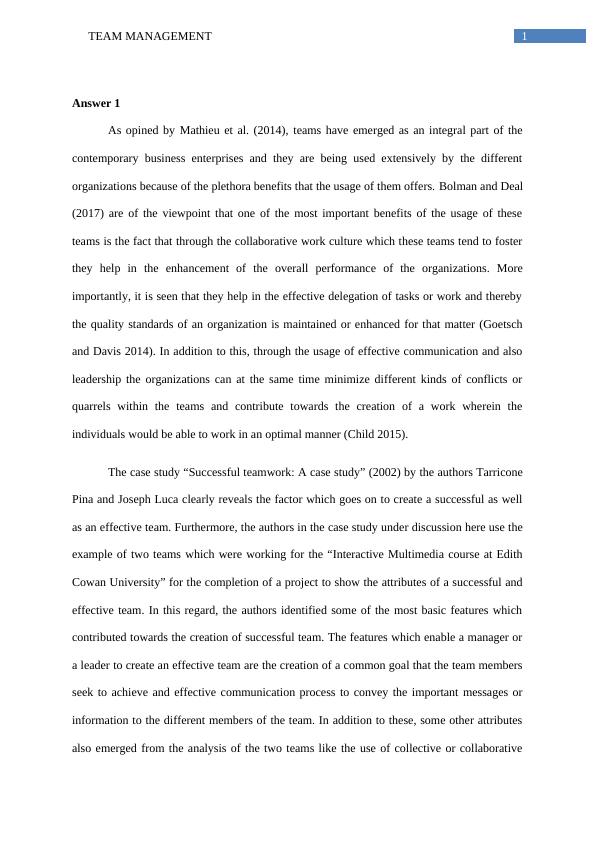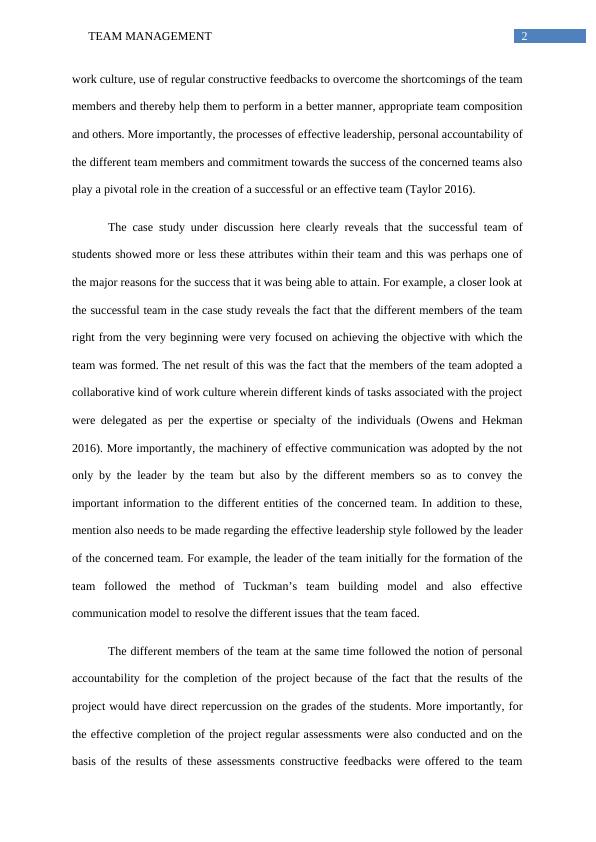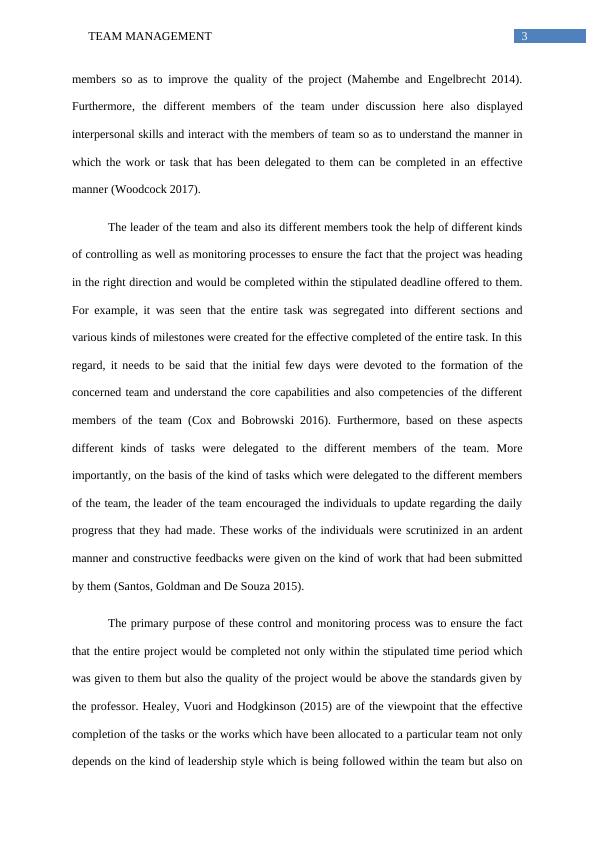Team Management
Added on 2023-05-30
11 Pages3527 Words203 Views
Running head: TEAM MANAGEMENT
Team Management
Name of the Student:
Name of the University:
Author’s Note:
Team Management
Name of the Student:
Name of the University:
Author’s Note:

1TEAM MANAGEMENT
Answer 1
As opined by Mathieu et al. (2014), teams have emerged as an integral part of the
contemporary business enterprises and they are being used extensively by the different
organizations because of the plethora benefits that the usage of them offers. Bolman and Deal
(2017) are of the viewpoint that one of the most important benefits of the usage of these
teams is the fact that through the collaborative work culture which these teams tend to foster
they help in the enhancement of the overall performance of the organizations. More
importantly, it is seen that they help in the effective delegation of tasks or work and thereby
the quality standards of an organization is maintained or enhanced for that matter (Goetsch
and Davis 2014). In addition to this, through the usage of effective communication and also
leadership the organizations can at the same time minimize different kinds of conflicts or
quarrels within the teams and contribute towards the creation of a work wherein the
individuals would be able to work in an optimal manner (Child 2015).
The case study “Successful teamwork: A case study” (2002) by the authors Tarricone
Pina and Joseph Luca clearly reveals the factor which goes on to create a successful as well
as an effective team. Furthermore, the authors in the case study under discussion here use the
example of two teams which were working for the “Interactive Multimedia course at Edith
Cowan University” for the completion of a project to show the attributes of a successful and
effective team. In this regard, the authors identified some of the most basic features which
contributed towards the creation of successful team. The features which enable a manager or
a leader to create an effective team are the creation of a common goal that the team members
seek to achieve and effective communication process to convey the important messages or
information to the different members of the team. In addition to these, some other attributes
also emerged from the analysis of the two teams like the use of collective or collaborative
Answer 1
As opined by Mathieu et al. (2014), teams have emerged as an integral part of the
contemporary business enterprises and they are being used extensively by the different
organizations because of the plethora benefits that the usage of them offers. Bolman and Deal
(2017) are of the viewpoint that one of the most important benefits of the usage of these
teams is the fact that through the collaborative work culture which these teams tend to foster
they help in the enhancement of the overall performance of the organizations. More
importantly, it is seen that they help in the effective delegation of tasks or work and thereby
the quality standards of an organization is maintained or enhanced for that matter (Goetsch
and Davis 2014). In addition to this, through the usage of effective communication and also
leadership the organizations can at the same time minimize different kinds of conflicts or
quarrels within the teams and contribute towards the creation of a work wherein the
individuals would be able to work in an optimal manner (Child 2015).
The case study “Successful teamwork: A case study” (2002) by the authors Tarricone
Pina and Joseph Luca clearly reveals the factor which goes on to create a successful as well
as an effective team. Furthermore, the authors in the case study under discussion here use the
example of two teams which were working for the “Interactive Multimedia course at Edith
Cowan University” for the completion of a project to show the attributes of a successful and
effective team. In this regard, the authors identified some of the most basic features which
contributed towards the creation of successful team. The features which enable a manager or
a leader to create an effective team are the creation of a common goal that the team members
seek to achieve and effective communication process to convey the important messages or
information to the different members of the team. In addition to these, some other attributes
also emerged from the analysis of the two teams like the use of collective or collaborative

2TEAM MANAGEMENT
work culture, use of regular constructive feedbacks to overcome the shortcomings of the team
members and thereby help them to perform in a better manner, appropriate team composition
and others. More importantly, the processes of effective leadership, personal accountability of
the different team members and commitment towards the success of the concerned teams also
play a pivotal role in the creation of a successful or an effective team (Taylor 2016).
The case study under discussion here clearly reveals that the successful team of
students showed more or less these attributes within their team and this was perhaps one of
the major reasons for the success that it was being able to attain. For example, a closer look at
the successful team in the case study reveals the fact that the different members of the team
right from the very beginning were very focused on achieving the objective with which the
team was formed. The net result of this was the fact that the members of the team adopted a
collaborative kind of work culture wherein different kinds of tasks associated with the project
were delegated as per the expertise or specialty of the individuals (Owens and Hekman
2016). More importantly, the machinery of effective communication was adopted by the not
only by the leader by the team but also by the different members so as to convey the
important information to the different entities of the concerned team. In addition to these,
mention also needs to be made regarding the effective leadership style followed by the leader
of the concerned team. For example, the leader of the team initially for the formation of the
team followed the method of Tuckman’s team building model and also effective
communication model to resolve the different issues that the team faced.
The different members of the team at the same time followed the notion of personal
accountability for the completion of the project because of the fact that the results of the
project would have direct repercussion on the grades of the students. More importantly, for
the effective completion of the project regular assessments were also conducted and on the
basis of the results of these assessments constructive feedbacks were offered to the team
work culture, use of regular constructive feedbacks to overcome the shortcomings of the team
members and thereby help them to perform in a better manner, appropriate team composition
and others. More importantly, the processes of effective leadership, personal accountability of
the different team members and commitment towards the success of the concerned teams also
play a pivotal role in the creation of a successful or an effective team (Taylor 2016).
The case study under discussion here clearly reveals that the successful team of
students showed more or less these attributes within their team and this was perhaps one of
the major reasons for the success that it was being able to attain. For example, a closer look at
the successful team in the case study reveals the fact that the different members of the team
right from the very beginning were very focused on achieving the objective with which the
team was formed. The net result of this was the fact that the members of the team adopted a
collaborative kind of work culture wherein different kinds of tasks associated with the project
were delegated as per the expertise or specialty of the individuals (Owens and Hekman
2016). More importantly, the machinery of effective communication was adopted by the not
only by the leader by the team but also by the different members so as to convey the
important information to the different entities of the concerned team. In addition to these,
mention also needs to be made regarding the effective leadership style followed by the leader
of the concerned team. For example, the leader of the team initially for the formation of the
team followed the method of Tuckman’s team building model and also effective
communication model to resolve the different issues that the team faced.
The different members of the team at the same time followed the notion of personal
accountability for the completion of the project because of the fact that the results of the
project would have direct repercussion on the grades of the students. More importantly, for
the effective completion of the project regular assessments were also conducted and on the
basis of the results of these assessments constructive feedbacks were offered to the team

3TEAM MANAGEMENT
members so as to improve the quality of the project (Mahembe and Engelbrecht 2014).
Furthermore, the different members of the team under discussion here also displayed
interpersonal skills and interact with the members of team so as to understand the manner in
which the work or task that has been delegated to them can be completed in an effective
manner (Woodcock 2017).
The leader of the team and also its different members took the help of different kinds
of controlling as well as monitoring processes to ensure the fact that the project was heading
in the right direction and would be completed within the stipulated deadline offered to them.
For example, it was seen that the entire task was segregated into different sections and
various kinds of milestones were created for the effective completed of the entire task. In this
regard, it needs to be said that the initial few days were devoted to the formation of the
concerned team and understand the core capabilities and also competencies of the different
members of the team (Cox and Bobrowski 2016). Furthermore, based on these aspects
different kinds of tasks were delegated to the different members of the team. More
importantly, on the basis of the kind of tasks which were delegated to the different members
of the team, the leader of the team encouraged the individuals to update regarding the daily
progress that they had made. These works of the individuals were scrutinized in an ardent
manner and constructive feedbacks were given on the kind of work that had been submitted
by them (Santos, Goldman and De Souza 2015).
The primary purpose of these control and monitoring process was to ensure the fact
that the entire project would be completed not only within the stipulated time period which
was given to them but also the quality of the project would be above the standards given by
the professor. Healey, Vuori and Hodgkinson (2015) are of the viewpoint that the effective
completion of the tasks or the works which have been allocated to a particular team not only
depends on the kind of leadership style which is being followed within the team but also on
members so as to improve the quality of the project (Mahembe and Engelbrecht 2014).
Furthermore, the different members of the team under discussion here also displayed
interpersonal skills and interact with the members of team so as to understand the manner in
which the work or task that has been delegated to them can be completed in an effective
manner (Woodcock 2017).
The leader of the team and also its different members took the help of different kinds
of controlling as well as monitoring processes to ensure the fact that the project was heading
in the right direction and would be completed within the stipulated deadline offered to them.
For example, it was seen that the entire task was segregated into different sections and
various kinds of milestones were created for the effective completed of the entire task. In this
regard, it needs to be said that the initial few days were devoted to the formation of the
concerned team and understand the core capabilities and also competencies of the different
members of the team (Cox and Bobrowski 2016). Furthermore, based on these aspects
different kinds of tasks were delegated to the different members of the team. More
importantly, on the basis of the kind of tasks which were delegated to the different members
of the team, the leader of the team encouraged the individuals to update regarding the daily
progress that they had made. These works of the individuals were scrutinized in an ardent
manner and constructive feedbacks were given on the kind of work that had been submitted
by them (Santos, Goldman and De Souza 2015).
The primary purpose of these control and monitoring process was to ensure the fact
that the entire project would be completed not only within the stipulated time period which
was given to them but also the quality of the project would be above the standards given by
the professor. Healey, Vuori and Hodgkinson (2015) are of the viewpoint that the effective
completion of the tasks or the works which have been allocated to a particular team not only
depends on the kind of leadership style which is being followed within the team but also on

End of preview
Want to access all the pages? Upload your documents or become a member.
Related Documents
Team Development and Team Performance | Analysislg...
|14
|3395
|25
Management People and Teams | Report | Newlg...
|8
|1665
|17
Importance of Team Work: A Case Studylg...
|7
|2021
|37
Impact of Organisational Culture on Employee Performancelg...
|83
|20157
|273
How Police Supervisory Styles Influence Patrol Officer Behaviorlg...
|5
|984
|178
Leadership Styleslg...
|14
|3527
|77
